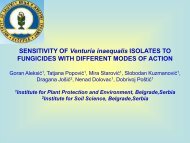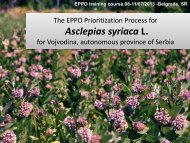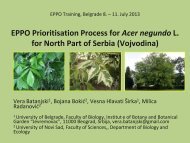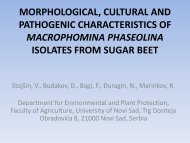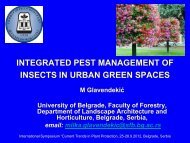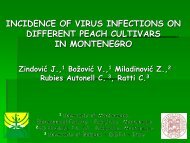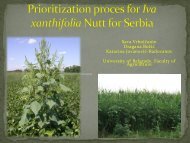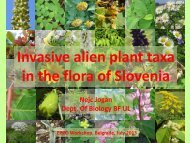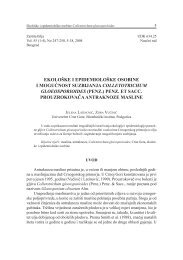Advantages and limitations in bioherbicides use
Advantages and limitations in bioherbicides use - Zvonko ... - Izbis
Advantages and limitations in bioherbicides use - Zvonko ... - Izbis
- No tags were found...
Create successful ePaper yourself
Turn your PDF publications into a flip-book with our unique Google optimized e-Paper software.
SINGH, H.P., BATISH, D.R., KOHLI, R.K. (2006): H<strong>and</strong>book of Susta<strong>in</strong>able Weed Management. Food Products press.<br />
B<strong>in</strong>ghamton, NY.<br />
TeBEEST, D.O. (1991): Microbial Control of weerds, (Ed., D.O. TeBeest). Chapman <strong>and</strong> Hall, Newyork. 284 pp.<br />
TeBEEST, D.O., YANG, X.B., CISAR, C.R. (1992a): The status of biological control of weeds with fungal pathogens. Annu. Rev.<br />
Phytopathol., 30: 637- 657.<br />
TeBEEST, D.O., CISAR, C.R., SPIEGEL, F.W. (1992b): Partial characterization of progeny from a cross between Colletotrichum<br />
gloeosporioides f. sp. aeschynomene <strong>and</strong> C. gloeosporioides from Carya. Plant Prot. Quar., 7: 171.<br />
WALKER, H.L. <strong>and</strong> SCIUMBATO G.L. (1981): Host range studies on four Alternaria isolates pathogenic to cotton (Gossypium<br />
spp.) or spurred anoda (Anoda cristata). Plant Sci. Lett., 22: 71-75.<br />
WALKER, H.L. <strong>and</strong> TILLEY, A.M. (1997): Evaluation of an isolate of Myrothecium verucaria from sicklepod (Senna obtusifolia)<br />
as a potential mycoherbicide agent. Biotogical Control, 10: 104-112.<br />
WATSON, A.K. <strong>and</strong> WYMORE, X. (1990): Identify<strong>in</strong>g limit<strong>in</strong>g factors <strong>in</strong> the biocontrol of weeds. In: New Direction <strong>in</strong><br />
Biological Control: Alternatives for Suppress<strong>in</strong>g Agricultural Pests <strong>and</strong> Diseases (ed. by Baker R.R. <strong>and</strong> Dunn P.E.). Alan R. Liss,<br />
New York, 305–316.<br />
WATSON, A.K. (2003): Where did it go wrong? Why is the concept of bioherbicide suffer<strong>in</strong>g from limited success? VI<br />
<strong>in</strong>ternational Bioherbicide Group Workshop, Canberra, Australia.<br />
WEIDEMANN, G.J. (1988): Effects of nutritional amendments on conidial production of Fusarium solani f. sp. cucurbitae on<br />
sodium alg<strong>in</strong>ate granules <strong>and</strong> on control of Texas gourd. Plant Dis., 72: 757-759.<br />
WEIDEMANN, G.J. <strong>and</strong> TeBEEST, D.O. (1990): Genetic variability of fungal pathogens <strong>and</strong> their weed hosts. p. 176-183 <strong>in</strong> R.<br />
E. Hoagl<strong>and</strong>, ed. Microbes <strong>and</strong> Microbial Products as Herbicides, ACS Symp. Ser. 439. American Chemical Society, Wash<strong>in</strong>gton,<br />
DC.<br />
WEIDEMANN, G.J. (1992): Risk assessment: determ<strong>in</strong><strong>in</strong>g genetic relatedness <strong>and</strong> potential asexual gene exchange <strong>in</strong> biocontrol<br />
fungi. Plant Prot. Quar., 7: 166-168.<br />
WHEELER, G.S. <strong>and</strong> CENTER, T.D. (2001): Impact of the biological control agent Hydrellia pakistanae (Dipetra: Ephydridae)<br />
on the submersed aquatic weed Hydrilla verticillata (Hydrocharitaceae). Biol. Control, 21: 168–181.<br />
WOMACK, J.G. <strong>and</strong> BURGE, M.N. (1993): Mycoherbicide formulation <strong>and</strong> the potential for bracken control. Pestic. Sci., 37:<br />
337-341.<br />
WOMACK, J.G., ECCLESTON, G.M., BURGE, M.N. (1996): A vegetable oil based <strong>in</strong>vert emulsion for mycoherbicide<br />
delivery. Biol. Control., 6: 23–28.<br />
WYMORE, L.A., POIRIER, C. WATSON, A.K., GOTLIEB, A.R. (1988): Colletotrichum coccodes, a potential bioherbicide for<br />
control of velvetleaf (Abutilon theophrasti). Plant Dis., 72: 534-538.<br />
ZHANG, W. (1999): Development of <strong>bioherbicides</strong> for biological control of cleavers. Alberta Research Council, Canadian Seed<br />
Growers, Association Research <strong>and</strong> Development Fund<strong>in</strong>g.



